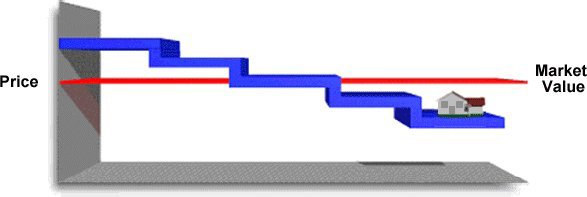Pricing Competitively Attracts More Buyers and Increases Your Chances for a Quick Sale!
Pricing Pyramid
How you price your home will directly impact upon how many buyers, showings and offers you attract, and ultimately how easily it sells. At the pyramid's center is the fair market value at which a reasonable percentage of buyers would view and purchase your home. When you underprice your home you'll attract a greater percentage of buyers, and when you overprice it you'll attact a lesser precentage of buyers.
____________________________________________________________________________
Consequences of Overpricing on Selling
Time and Price
The strategy of overpricing your property - knowing that you can reduce the price later -- might make sence at first glance. However, it seldom works. In fact, sellers who overprice their properties -even just 10% above market value -- often end up getting less than they would if they had priced it properly form the start.
Here is why
- A high price on your property makes other comparable properties more attactive, so you actually help to sell your competition.
- Fewer buyers will respond to ads, fewer agents will show your property to their buyer clients, and you'll get fewer serious offers.
- Inflated prices often lead to mortgage rejections and critical lost time waiting for finance approvals that don't go through.
- Reducing the price after buyers have begun to perceive your home as a "stale" listing will not generate nearly as much interest as if you'd priced it properly from the start.

________________________________________________________________________________
Strategically Pricing Your Property to Sell It for Top Dollar
Pricing your Property Is a Balancing ActOn the one hand, you want to set a listing price that maximizes interest among qualified, motivated buyers who will be willing to pay top dollar for your property. Indeed, such buyers will ultimately determine your property's top market value.
On the other hand, you do not want to set a listing price that attracts a lot of buyer prospects, but sets the stage for negotiations that result in your getting less than what your property is really worth.
Your Home's Actual Market ValueIn a perfect world, your home's value would be everything you think you need it to be. However, simply put, your home's value is not determined by you, but by what the market is willing to pay for it at a given time.
These days, the "market" increasingly refers to home buyers who have researched property values over the Internet for months, have already viewed a number of homes, and are not under any undue pressure to buy.
You can determine a value range for your home by looking at the recent sale prices and current asking prices of homes similar to yours in your area. At your request we can prepare a Comparative Market Analysis (CMA) that includes a variety of "comparable" homes drawn from the local Multiple Listing Service (MLS).
The Bottom Line: REALISTIC IS STRATEGIC!
On average, serious buyers look at about fifteen properties before they make an offer. Doing so gives them a basis for determining how competitively a property is priced, both in terms of the market and generally what they are looking for.
The seller wants to get the maximum amount possible for their proposal, but generally may also set a limit for the least amount they will accept. This is the amount where they draw the line, also known as the "walk away" from the deal point.
The buyer, on the other hand, wants to pay the least amount possible, but may consider a higher amount that they might be prepared to pay as well. The maximum amount they are prepared to pay is the amount at which they are willing to "walk away" from the deal point.
The difference between these respective lows and highs of both the seller and buyer, are their range of expectations. When you have an overlap between these two different ranges, this is known as the Zone of Possible Agreement.
If you overprice your property you'll usually lose serious buyers even if they otherwise love it. Experience shows that buyers usually do not make what they consider to be realistic offers on overpriced properties because they assume that doing so will just be a waste of time. The overlap between buyer and seller price ranges is depicted below. It will be helpful to keep this diagram in mind when pricing your property.

A home must receive maximum market exposure and also be presented in a way that highlights its unique characters and features.
When you've decided to sell, I will be your advocate, your guide and your fierce negotiator. I will work hard to make yours a Great Sale!
SELL AT EASE $$ SAVE $$ BUY AT EASE


